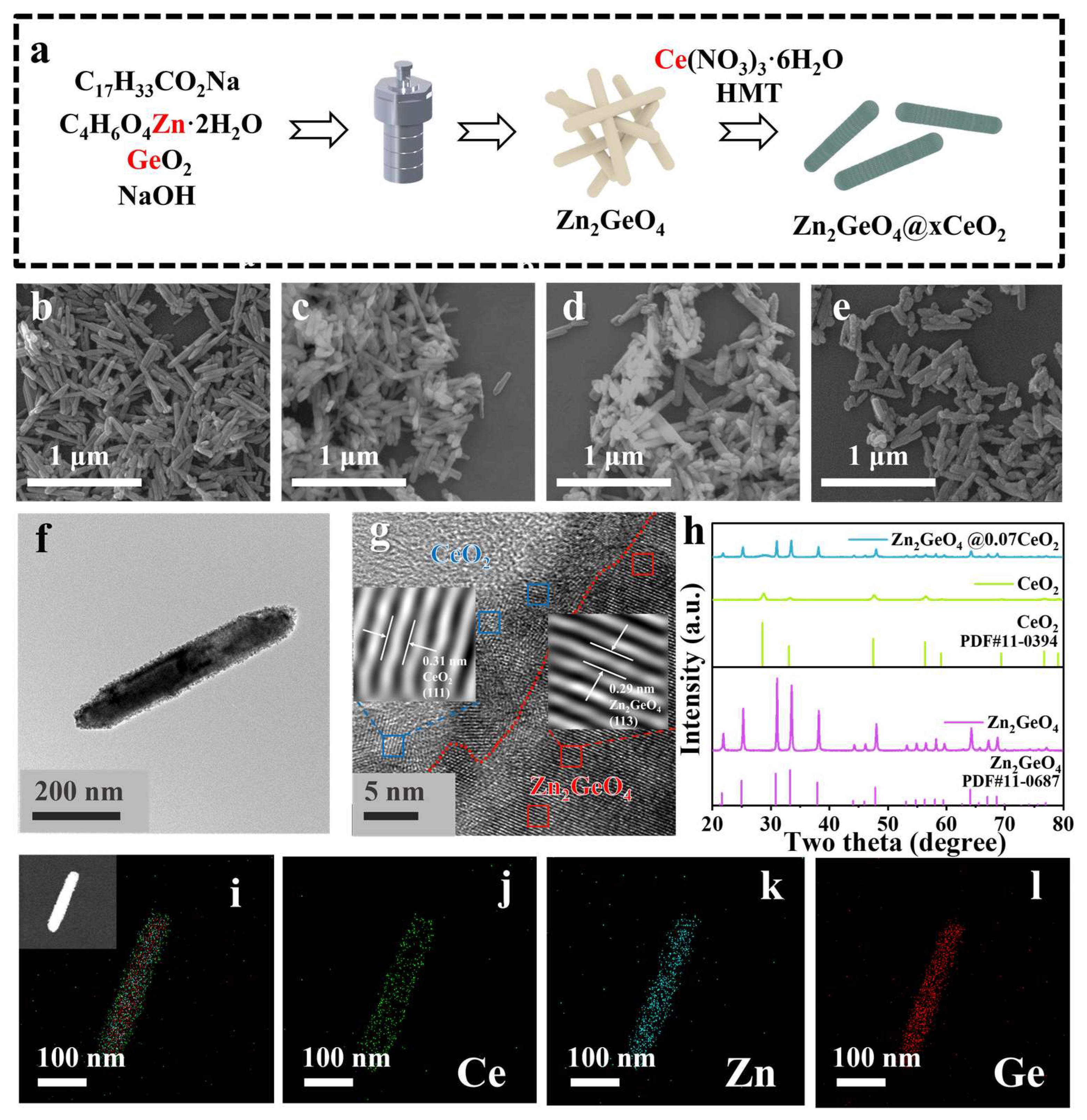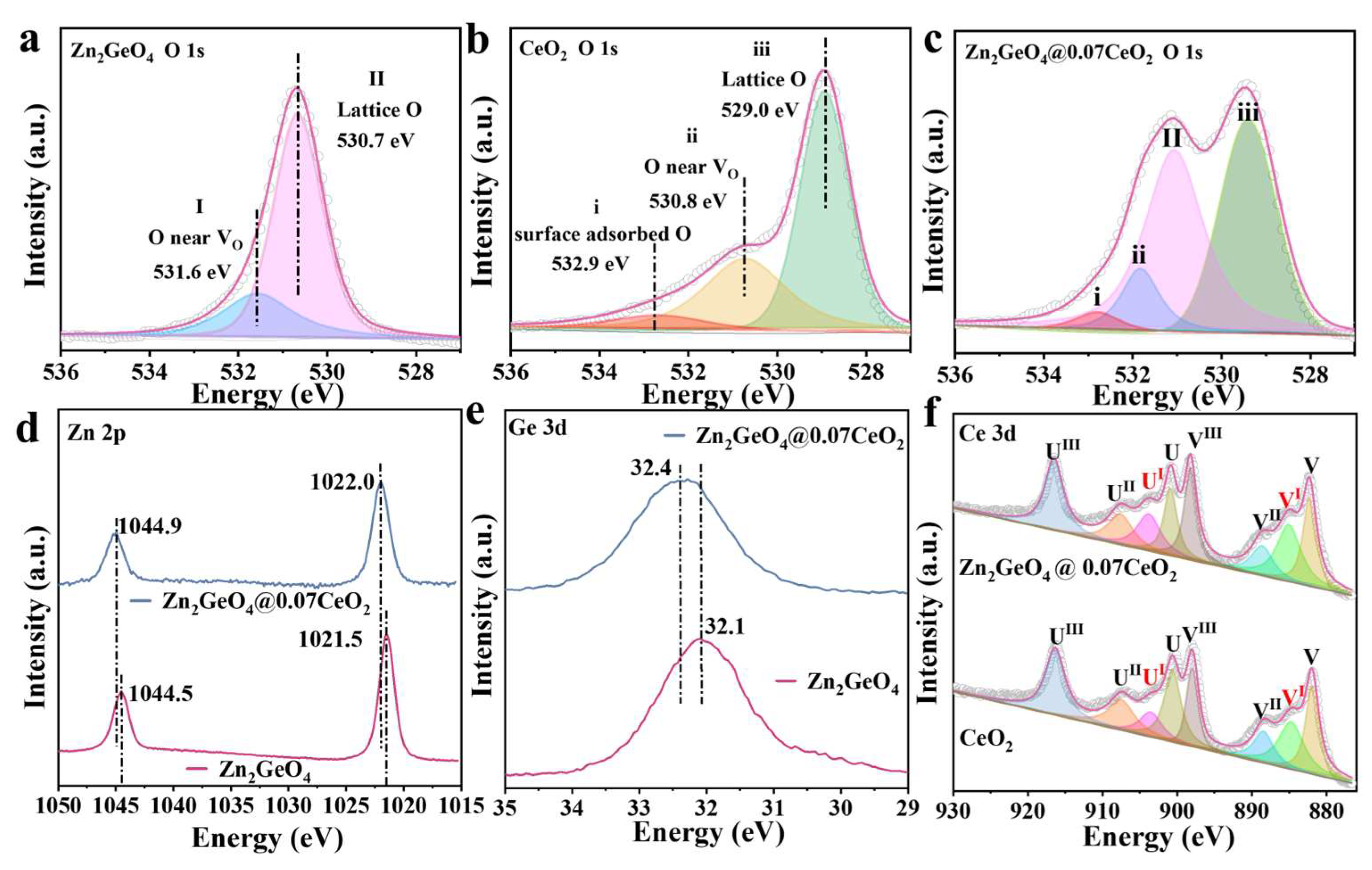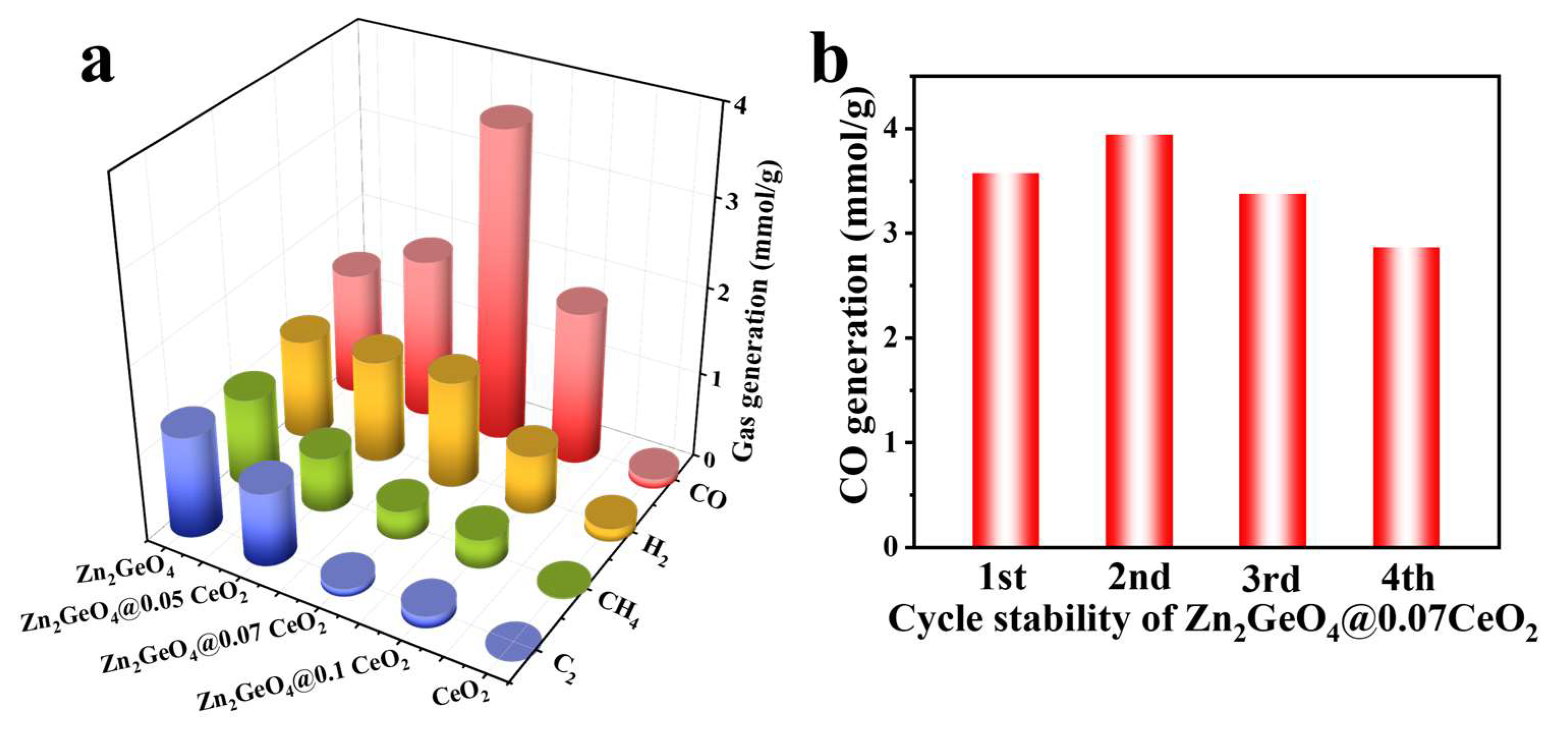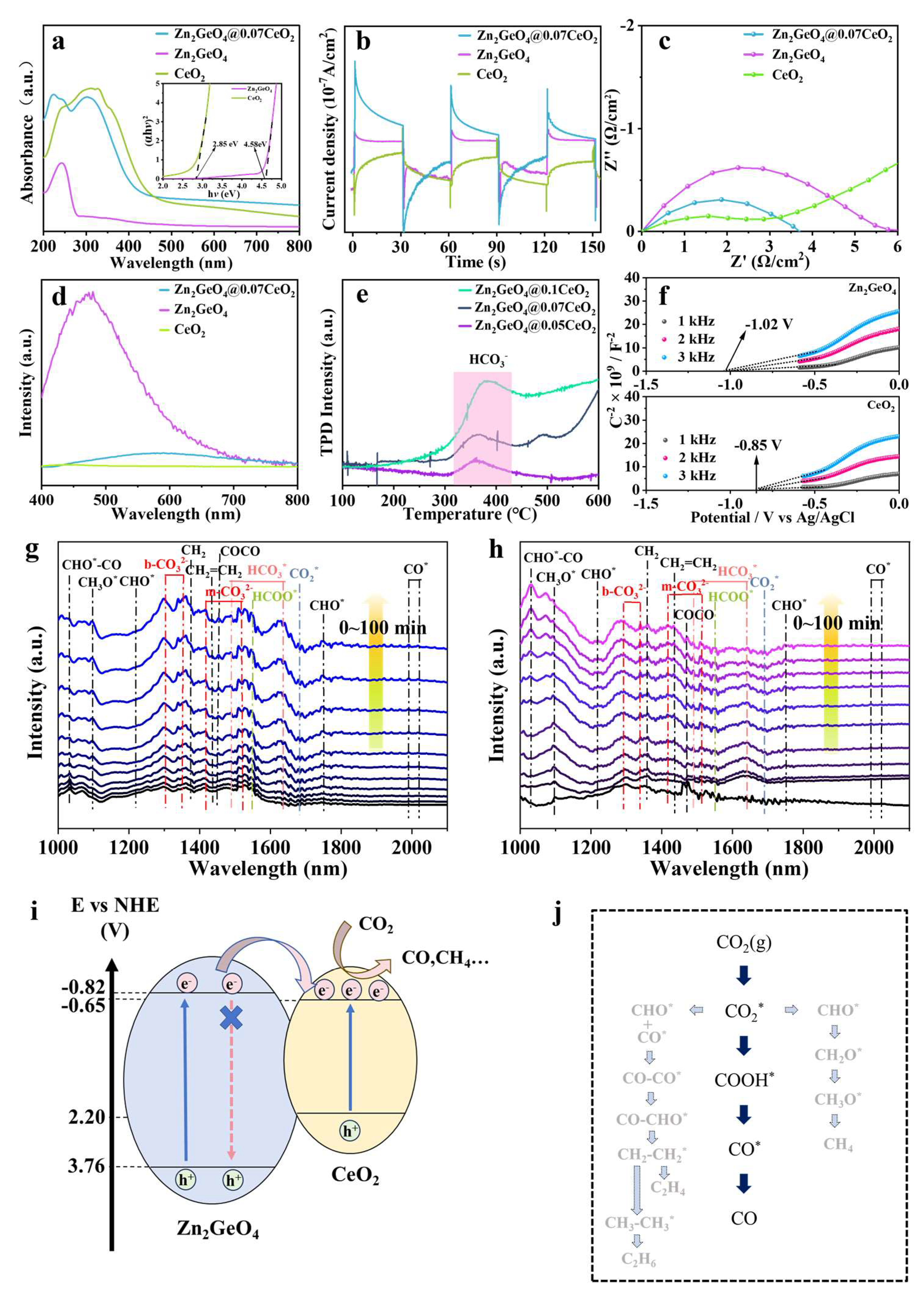Zn2GeO4@CeO2 Core@Shell Nanorods for Efficient Photocatalytic CO2 Reduction
Abstract
1. Introduction
2. Results and Discussion
3. Materials and Methods
3.1. Synthesis of Zn2GeO4
3.2. Synthesis of CeO2
3.3. Synthesis of Zn2GeO4@xCeO2
3.4. Characterization
3.5. Photocatalytic Performance Measurements
3.6. Photoelectrochemical Measurements
4. Conclusions
Supplementary Materials
Author Contributions
Funding
Institutional Review Board Statement
Informed Consent Statement
Data Availability Statement
Conflicts of Interest
References
- Chang, X.; Wang, T.; Gong, J. CO2 Photo-Reduction: Insights into CO2 Activation and Reaction on Surfaces of Photocatalysts. Energy Environ. Sci. 2016, 9, 2177–2196. [Google Scholar] [CrossRef]
- Huang, H.; Tu, S.; Zeng, C.; Zhang, T.; Reshak, A.H.; Zhang, Y. Macroscopic Polarization Enhancement Promoting Photo- and Piezoelectric-Induced Charge Separation and Molecular Oxygen Activation. Angew. Chem. Int. Ed. 2017, 56, 11860–11864. [Google Scholar] [CrossRef]
- Shangguan, W.; Liu, Q.; Wang, Y.; Sun, N.; Liu, Y.; Zhao, R.; Li, Y.; Wang, C.; Zhao, J. Molecular-Level Insight into Photocatalytic CO2 Reduction with H2O over Au Nanoparticles by Interband Transitions. Nat. Commun. 2022, 13, 3894. [Google Scholar] [CrossRef]
- Yao, S.; He, J.; Gao, F.; Wang, H.; Lin, J.; Bai, Y.; Fang, J.; Zhu, F.; Huang, F.; Wang, M. Highly Selective Semiconductor Photocatalysis for CO2 Reduction. J. Mater. Chem. A 2023, 11, 12539–12558. [Google Scholar] [CrossRef]
- Zhu, X.; Zhou, G.; Yi, J.; Ding, P.; Yang, J.; Zhong, K.; Song, Y.; Hua, Y.; Zhu, X.; Yuan, J.; et al. Accelerated Photoreduction of CO2 to CO over a Stable Heterostructure with a Seamless Interface. ACS Appl. Mater. Interfaces 2021, 13, 39523–39532. [Google Scholar] [CrossRef] [PubMed]
- Zhou, W.; Cheng, K.; Kang, J.; Zhou, C.; Subramanian, V.; Zhang, Q.; Wang, Y. New Horizon in C1 Chemistry: Breaking the Selectivity Limitation in Transformation of Syngas and Hydrogenation of CO2 into Hydrocarbon Chemicals and Fuels. Chem. Soc. Rev. 2019, 48, 3193–3228. [Google Scholar] [CrossRef]
- He, F.; Zhu, B.; Cheng, B.; Yu, J.; Ho, W.; Macyk, W. 2D/2D/0D TiO2/C3N4/Ti3C2 MXene Composite S-Scheme Photocatalyst with Enhanced CO2 Reduction Activity. Appl. Catal. B Environ. 2020, 272, 119006. [Google Scholar] [CrossRef]
- She, H.; Hua, R.; Zhao, J.; Xia, Y.; Wang, L.; Huang, J.; Wang, Q. Synergetic Regulation of Interfacial Electronic Structure of Cu, N Co-Doped Carbon Modified TiO2 for Efficient Photocatalytic CO2 Reduction. Chem. Eng. J. 2024, 496, 153799. [Google Scholar] [CrossRef]
- Zhu, J.; Shao, W.; Li, X.; Jiao, X.; Zhu, J.; Sun, Y.; Xie, Y. Asymmetric Triple-Atom Sites Confined in Ternary Oxide Enabling Selective CO2 Photothermal Reduction to Acetate. J. Am. Chem. Soc. 2021, 143, 18233–18241. [Google Scholar] [CrossRef]
- Jiang, G.; Tang, B.; Li, X.; Wei, Z.; Wang, X.; Chen, W.; Wan, J.; Shen, L. Preparation of Ag-Modified Zn2GeO4 Nanorods for Photo-Degradation of Organic Pollutants. Powder Technol. 2014, 251, 37–40. [Google Scholar] [CrossRef]
- Li, M.; Wu, S.; Liu, D.; Ye, Z.; Wang, L.; Kan, M.; Ye, Z.; Khan, M.; Zhang, J. Engineering Spatially Adjacent Redox Sites with Synergistic Spin Polarization Effect to Boost Photocatalytic CO2 Methanation. J. Am. Chem. Soc. 2024, 146, 15538–15548. [Google Scholar] [CrossRef] [PubMed]
- Wang, J.; Zhang, H.; Nian, Y.; Chen, Y.; Cheng, H.; Yang, C.; Han, Y.; Tan, X.; Ye, J.; Yu, T. Disruption Symmetric Crystal Structure Favoring Photocatalytic CO2 Reduction: Reduced *COOH Formation Energy Barrier on Al Doped CuS/TiO2. Adv. Funct. Mater. 2024, 34, 2406549. [Google Scholar] [CrossRef]
- Low, J.; Yu, J.; Jaroniec, M.; Wageh, S.; Al-Ghamdi, A.A. Heterojunction Photocatalysts. Adv. Mater. 2017, 29, 1601694. [Google Scholar] [CrossRef]
- Lai, K.; Sun, Y.; Li, N.; Gao, Y.; Li, H.; Ge, L.; Ma, T. Photocatalytic CO2-to-CH4 Conversion with Ultrahigh Selectivity of 95.93% on S-Vacancy Modulated Spatial In2S3/In2O3 Heterojunction. Adv. Funct. Mater. 2024, 34, 2409031. [Google Scholar] [CrossRef]
- Cao, S.; Yu, J.; Wageh, S.; Al-Ghamdi, A.A.; Mousavi, M.; Ghasemi, J.B.; Xu, F. H2-Production and Electron-Transfer Mechanism of a Noble-Metal-Free WO3@ZnIn2S4 S-Scheme Heterojunction Photocatalyst. J. Mater. Chem. A 2022, 10, 17174–17184. [Google Scholar] [CrossRef]
- Pan, C.; Xu, J.; Wang, Y.; Li, D.; Zhu, Y. Dramatic Activity of C3N4/BiPO4 Photocatalyst with Core/Shell Structure Formed by Self-Assembly. Adv. Funct. Mater. 2012, 22, 1518–1524. [Google Scholar] [CrossRef]
- Wang, L.; Cheng, B.; Zhang, L.; Yu, J. In Situ Irradiated XPS Investigation on S-Scheme TiO2@ZnIn2S4 Photocatalyst for Efficient Photocatalytic CO2 Reduction. Small 2021, 17, 2103447. [Google Scholar] [CrossRef] [PubMed]
- Deng, X.; Zhang, J.; Qi, K.; Liang, G.; Xu, F.; Yu, J. Ultrafast Electron Transfer at the In2O3/Nb2O5 S-Scheme Interface for CO2 Photoreduction. Nat. Commun. 2024, 15, 4807. [Google Scholar] [CrossRef]
- Cheng, Z.; Yu, M.; Yang, G.; Kang, L. Fabrication of NiCo2O4@CeO2 Core@shell Nanotubes with Enhanced Catalytic Performances. CrystEngComm 2016, 18, 6331–6335. [Google Scholar] [CrossRef]
- Yan, T.; Liu, H.; Gao, P.; Sun, M.; Wei, Q.; Xu, W.; Wang, X.; Du, B. Facile Synthesized Highly Active BiOI/Zn2GeO4 Composites for the Elimination of Endocrine Disrupter BPA under Visible Light Irradiation. New J. Chem. 2015, 39, 3964–3972. [Google Scholar] [CrossRef]
- Liu, Q.; Zhou, Y.; Kou, J.; Chen, X.; Tian, Z.; Gao, J.; Yan, S.; Zou, Z. High-Yield Synthesis of Ultralong and Ultrathin Zn2GeO4 Nanoribbons toward Improved Photocatalytic Reduction of CO2 into Renewable Hydrocarbon Fuel. J. Am. Chem. Soc. 2010, 132, 14385–14387. [Google Scholar] [CrossRef] [PubMed]
- Wang, Y.; Zheng, M.; Zhao, H.; Qin, H.; Fan, W.; Zhao, X. Zn2GeO4−x/ZnS Heterojunctions Fabricated via in Situ Etching Sulfurization for Pt-Free Photocatalytic Hydrogen Evolution: Interface Roughness and Defect Engineering. Phys. Chem. Chem. Phys. 2020, 22, 10265–10277. [Google Scholar] [CrossRef]
- Wang, Y.; Zhao, X.; Wei, Q.; He, P.; Cheng, Z.; Wu, J.; Qi, Y.; Sun, Y.; Song, J.; Yang, W. Cu3SnS4/CeO2 Heterojunction Photocatalyst with Dual Redox Pairs Synergistically Promotes the Photocatalytic Reduction of CO2. Energy Fuels 2022, 36, 7763–7774. [Google Scholar] [CrossRef]
- Zhu, C.; Wei, X.; Li, W.; Pu, Y.; Sun, J.; Tang, K.; Wan, H.; Ge, C.; Zou, W.; Dong, L. Crystal-Plane Effects of CeO2 {110} and CeO2 {100} on Photocatalytic CO2 Reduction: Synergistic Interactions of Oxygen Defects and Hydroxyl Groups. ACS Sustain. Chem. Eng. 2020, 8, 14397–14406. [Google Scholar] [CrossRef]
- Cai, J.; Li, D.; Jiang, L.; Yuan, J.; Li, Z.; Li, K. Review on CeO2-Based Photocatalysts for Photocatalytic Reduction of CO2: Progresses and Perspectives. Energy Fuels 2023, 37, 4878–4897. [Google Scholar] [CrossRef]
- Liu, L.; Shi, J.; Wang, R. Facile Construction of Mn2O3@CeO2 Core@shell Cubes with Enhanced Catalytic Activity toward CO Oxidation. J. Solid State Chem. 2019, 269, 419–427. [Google Scholar] [CrossRef]
- Wang, X.; Liu, D.; Li, J.; Zhen, J.; Zhang, H. Clean Synthesis of Cu2O@CeO2 Core@shell Nanocubes with Highly Active Interface. NPG Asia Mater. 2015, 7, e158. [Google Scholar] [CrossRef]
- Huang, J.; Ding, K.; Hou, Y.; Wang, X.; Fu, X. Synthesis and Photocatalytic Activity of Zn2GeO4 Nanorods for the Degradation of Organic Pollutants in Water. ChemSusChem 2008, 1, 1011–1019. [Google Scholar] [CrossRef]
- Ma, Z.; Liu, X.; Wang, X.; Luo, Z.; Li, W.; Nie, Y.; Pei, L.; Mao, Q.; Wen, X.; Zhong, J. Manipulating the D-Band Center Enhances Photoreduction of CO2 to CO in Zn2GeO4 Nanorods. Chem. Eng. J. 2023, 468, 143569. [Google Scholar] [CrossRef]
- Dolado, J.; Martínez-Casado, R.; Hidalgo, P.; Gutierrez, R.; Dianat, A.; Cuniberti, G.; Domínguez-Adame, F.; Díaz, E.; Méndez, B. Understanding the UV Luminescence of Zinc Germanate: The Role of Native Defects. Acta Mater. 2020, 196, 626–634. [Google Scholar] [CrossRef]
- Zhao, Y.; Yang, S.; Zhu, J.; Ji, G.; Peng, F. The Study of Oxygen Ion Motion in Zn2GeO4 by Raman Spectroscopy. Solid State Ion. 2015, 274, 12–16. [Google Scholar] [CrossRef]
- Qin, Y.; Liu, X.; Zhu, T.; Zhu, T. Catalytic Oxidation of Ethyl Acetate over Silver Catalysts Supported on CeO2 with Different Morphologies. Mater. Chem. Phys. 2019, 229, 32–38. [Google Scholar] [CrossRef]
- Guo, Y.; Li, H.; Ma, W.; Shi, W.; Zhu, Y.; Choi, W. Photocatalytic Activity Enhanced via Surface Hybridization. Carbon Energy 2020, 2, 308–349. [Google Scholar] [CrossRef]
- Wang, N.; Cheong, S.; Yoon, D.-E.; Lu, P.; Lee, H.; Lee, Y.K.; Park, Y.-S.; Lee, D.C. Efficient, Selective CO2 Photoreduction Enabled by Facet-Resolved Redox-Active Sites on Colloidal CdS Nanosheets. J. Am. Chem. Soc. 2022, 144, 16974–16983. [Google Scholar] [CrossRef] [PubMed]
- Wang, C.; Ni, H.; Dai, J.; Liu, T.; Wu, Z.; Chen, X.; Dong, Z.; Qian, J.; Wu, Z. Comparison of Highly Active Type-I and Type-II Heterojunction Photocatalytic Composites Synthesized by Electrospinning for Humic Acid Degradation. Chem. Phys. Lett. 2022, 803, 139815. [Google Scholar] [CrossRef]
- Cui, Z.; Wang, W.; Zhao, C.; Chen, C.; Han, M.; Wang, G.; Zhang, Y.; Zhang, H.; Zhao, H. Spontaneous Redox Approach to the Self-Assembly Synthesis of Au/CeO2 Plasmonic Photocatalysts with Rich Oxygen Vacancies for Selective Photocatalytic Conversion of Alcohols. ACS Appl. Mater. Interfaces 2018, 10, 31394–31403. [Google Scholar] [CrossRef] [PubMed]
- Qi, L.; Yu, Q.; Dai, Y.; Tang, C.; Liu, L.; Zhang, H.; Gao, F.; Dong, L.; Chen, Y. Influence of Cerium Precursors on the Structure and Reducibility of Mesoporous CuO-CeO2 Catalysts for CO Oxidation. Appl. Catal. B Environ. 2012, 119–120, 308–320. [Google Scholar] [CrossRef]
- Li, X.; Wang, M.; Wang, R.; Wang, Y.; Zhu, M.; Zhang, L.; Shi, J. Construction of Ru Single-Atoms on Ceria to Reform the Products of CO2 Photoreduction. ACS Nano 2024, 18, 5741–5751. [Google Scholar] [CrossRef]
- Li, X.; Liu, Q.; Wang, J.; Meng, D.; Shu, Y.; Lv, X.; Zhao, B.; Yang, H.; Cheng, T.; Gao, Q.; et al. Enhanced Electroreduction of CO2 to C2+ Products on Heterostructured Cu/Oxide Electrodes. Chem 2022, 8, 2148–2162. [Google Scholar] [CrossRef]
- Wang, S.; Wang, Y.; Zhang, S.L.; Zang, S.; Lou, X.W. Supporting Ultrathin ZnIn2S4 Nanosheets on Co/N-Doped Graphitic Carbon Nanocages for Efficient Photocatalytic H2 Generation. Adv. Mater. 2019, 31, 1903404. [Google Scholar] [CrossRef]
- Kim, D.; Yong, K. Boron Doping Induced Charge Transfer Switching of a C3N4/ZnO Photocatalyst from Z-Scheme to Type II to Enhance Photocatalytic Hydrogen Production. Appl. Catal. B Environ. 2021, 282, 119538. [Google Scholar] [CrossRef]
- Spilarewicz, K.; Urbanek, K.; Jakimińska, A.; Macyk, W. ZnFe2O4/TiO2 Composites with Type-I Heterojunction for Photocatalytic Reduction of CO2. J. CO2 Util. 2023, 75, 102574. [Google Scholar] [CrossRef]
- Tang, H. Vapor Phase Growth and Photoluminescence of Oriented-Attachment Zn2GeO4 Nanorods Array. J. Cryst. Growth 2016, 451, 170–173. [Google Scholar] [CrossRef]
- Zheng, J.; Li, S.; Zhang, Y.; Zheng, P.; Hu, X.; Fang, Y.; Duan, R.; Chen, Q. Ag–O–Ce3+ Atomic Interface and Surface Oxygen Vacancies on CeO2 Synergistically Promoted the Selective Visible Photocatalytic Reduction of Carbon Dioxide. J. Mater. Chem. C 2023, 11, 7320–7330. [Google Scholar] [CrossRef]
- Pu, Y.; Luo, Y.; Wei, X.; Sun, J.; Li, L.; Zou, W.; Dong, L. Synergistic Effects of Cu2O-Decorated CeO2 on Photocatalytic CO2 Reduction: Surface Lewis Acid/Base and Oxygen Defect. Appl. Catal. B Environ. 2019, 254, 580–586. [Google Scholar] [CrossRef]
- Yang, S.; Zhang, W.; Pan, G.; Chen, J.; Deng, J.; Chen, K.; Xie, X.; Han, D.; Dai, M.; Niu, L. Photocatalytic Co-Reduction of N2 and CO2 with CeO2 Catalyst for Urea Synthesis. Angew. Chem. Int. Ed. 2023, 62, e202312076. [Google Scholar] [CrossRef]
- Yuan, Y.; Dai, H.; Chi, H.; Gao, W.; Liu, Q.; Ding, C.; Shen, Y.; Tang, Z.; Zhuang, C.; Yang, Y.; et al. Atomically Thin Zn2GeO4 Nanoribbons: Facile Synthesis and Selective Photocatalytic CO2 Reduction toward CO. ACS Mater. Lett. 2022, 4, 2631–2637. [Google Scholar] [CrossRef]
- Li, Y.; Zhao, A.; Chen, C.; Zhang, C.; Zhang, J.; Jia, G. Controllable Synthesis and Morphology-Dependent Photoluminescence Properties of Well-Defined One-Dimensional Zn2GeO4:Mn2+ Nanostructures. Dyes Pigm. 2018, 150, 267–274. [Google Scholar] [CrossRef]
- Li, X.; Liu, B.; Wen, M.; Gao, Y.; Wu, H.; Huang, M.; Li, Z.; Chen, B.; Tung, C.; Wu, L. Hole-Accepting-Ligand-Modified CdSe QDs for Dramatic Enhancement of Photocatalytic and Photoelectrochemical Hydrogen Evolution by Solar Energy. Adv. Sci. 2016, 3, 1500282. [Google Scholar] [CrossRef]
- Su, B.; Zheng, M.; Lin, W.; Lu, X.F.; Luan, D.; Wang, S.; Lou, X.W. (David). S-Scheme Co9S8@Cd0.8Zn0.2S-DETA Hierarchical Nanocages Bearing Organic CO2 Activators for Photocatalytic Syngas Production. Adv. Energy Mater. 2023, 13, 2203290. [Google Scholar] [CrossRef]
- Zeng, R.; Liu, T.; Qiu, M.; Tan, H.; Gu, Y.; Ye, N.; Dong, Z.; Li, L.; Lin, F.; Sun, Q.; et al. High-Volumetric Density Atomic Cobalt on Multishell ZnxCd1–xS Boosts Photocatalytic CO2 Reduction. J. Am. Chem. Soc. 2024, 146, 9721–9727. [Google Scholar] [CrossRef] [PubMed]
- Liu, Z.; Chen, Z.; Li, M.; Li, J.; Zhuang, W.; Yang, X.; Wu, S.; Zhang, J. Construction of Single Ni Atom-Immobilized ZIF-8 with Ordered Hierarchical Pore Structures for Selective CO2 Photoreduction. ACS Catal. 2023, 13, 6630–6640. [Google Scholar] [CrossRef]
- Zhang, G.; Wang, Z.; He, T.; Wu, J.; Zhang, J.; Wu, J. Rationally Design and In-Situ Fabrication of Ultrasmall Pomegranate-like CdIn2S4/ZnIn2S4 Z-Scheme Heterojunction with Abundant Vacancies for Improving CO2 Reduction and Water Splitting. Chem. Eng. J. 2022, 442, 136309. [Google Scholar] [CrossRef]
- Huang, N.; Li, B.; Wu, D.; Chen, Z.; Shao, B.; Chen, D.; Zheng, Y.; Wang, W.; Yang, C.; Gu, M.; et al. Crystal Engineering of MOF-Derived Bimetallic Oxide Solid Solution Anchored with Au Nanoparticles for Photocatalytic CO2 Reduction to Syngas and C2 Hydrocarbons. Angew. Chem. Int. Ed 2024, 63, e202319177. [Google Scholar] [CrossRef]
- Wang, W.; Deng, C.; Xie, S.; Li, Y.; Zhang, W.; Sheng, H.; Chen, C.; Zhao, J. Photocatalytic C–C Coupling from Carbon Dioxide Reduction on Copper Oxide with Mixed-Valence Copper(I)/Copper(II). J. Am. Chem. Soc. 2021, 143, 2984–2993. [Google Scholar] [CrossRef]
- Wei, J.; Mu, X.; Hu, Y.; Liu, L.; Wu, X.; Liu, Q.; Zhang, T.; Peng, Y.; Cao, J.; Yan, C.; et al. A General Preparation of Solid Solution-Oxide Heterojunction Photocatalysts through Metal–Organic Framework Transformation Induced Pre-nucleation. Angew. Chem. Int. Ed. 2023, 62, e202302986. [Google Scholar] [CrossRef]
- Zhao, H.; Wang, X.; Feng, J.; Chen, Y.; Yang, X.; Gao, S.; Cao, R. Synthesis and Characterization of Zn2GeO4/Mg-MOF-74 Composites with Enhanced Photocatalytic Activity for CO2 Reduction. Catal. Sci. Technol. 2018, 8, 1288. [Google Scholar] [CrossRef]
- Wang, J.; Huang, L.; Sun, B.; Zhang, H.; Hou, D.; Qiao, X.; Ma, H.; Li, D.-S. Efficient Photothermal Catalytic CO2 Reduction over in Situ Construction ZnIn2S4@Ni(OH)2/NiO Z-Scheme Heterojunction. Chem. Eng. J. 2024, 479, 147719. [Google Scholar] [CrossRef]
- Jia, W.; Xiong, R.; Sun, Y.; Xiao, Y.; Cheng, B.; Lei, S. A Well-Designed Hierarchical Bi19S27Br3 nanorods@SnIn4S8 Nanosheet Core–Shell S-Scheme Heterostructure for Robust Photothermal-Assisted Photocatalytic CO2 Reduction. J. Mater. Chem. A 2024, 12, 4513–4524. [Google Scholar] [CrossRef]
- Liu, X.; Wu, Y.; Li, Y.; Yang, X.; Ma, Q.; Luo, J. MOF-on-MOF-Derived CuO@In2O3 S-Scheme Heterojunction with Core–Shell Structure for Efficient Photocatalytic CO2 Reduction. Chem. Eng. J. 2024, 485, 149855. [Google Scholar] [CrossRef]
- Yang, S.; Byun, W.J.; Zhao, F.; Chen, D.; Mao, J.; Zhang, W.; Peng, J.; Liu, C.; Pan, Y.; Hu, J.; et al. CO2 Enrichment Boosts Highly Selective Infrared-Light-Driven CO2 Conversion to CH4 by UiO-66/Co9S8 Photocatalyst. Adv. Mater. 2024, 36, 2312616. [Google Scholar] [CrossRef] [PubMed]
- Wang, M.; Shen, M.; Jin, X.; Tian, J.; Zhou, Y.; Shao, Y.; Zhang, L.; Li, Y.; Shi, J. Mild Generation of Surface Oxygen Vacancies on CeO2 for Improved CO2 Photoreduction Activity. Nanoscale 2020, 12, 12374–12382. [Google Scholar] [CrossRef] [PubMed]
- Wang, M.; Shen, M.; Jin, X.; Tian, J.; Shao, Y.; Zhang, L.; Li, Y.; Shi, J. Exploring the Enhancement Effects of Hetero-Metal Doping in CeO2 on CO2 Photocatalytic Reduction Performance. Chem. Eng. J. 2022, 427, 130987. [Google Scholar] [CrossRef]
- Wang, Y.; Zhuang, G.; Zhang, J.; Luo, F.; Cheng, X.; Sun, F.; Fu, S.; Lu, T.; Zhang, Z. Co-Dissolved Isostructural Polyoxovanadates to Construct Single-Atom-Site Catalysts for Efficient CO2 Photoreduction. Angew. Chem. Int. Ed. 2023, 62, e202216592. [Google Scholar] [CrossRef]
- Wang, J.; Yang, C.; Mao, L.; Cai, X.; Geng, Z.; Zhang, H.; Zhang, J.; Tan, X.; Ye, J.; Yu, T. Regulating the Metallic Cu–Ga Bond by S Vacancy for Improved Photocatalytic CO2 Reduction to C2H4. Adv. Funct. Mater. 2023, 33, 2213901. [Google Scholar] [CrossRef]




Disclaimer/Publisher’s Note: The statements, opinions and data contained in all publications are solely those of the individual author(s) and contributor(s) and not of MDPI and/or the editor(s). MDPI and/or the editor(s) disclaim responsibility for any injury to people or property resulting from any ideas, methods, instructions or products referred to in the content. |
© 2025 by the authors. Licensee MDPI, Basel, Switzerland. This article is an open access article distributed under the terms and conditions of the Creative Commons Attribution (CC BY) license (https://creativecommons.org/licenses/by/4.0/).
Share and Cite
Sun, J.; Bai, Y.; Feng, X.; Liu, D.; Zhang, Y. Zn2GeO4@CeO2 Core@Shell Nanorods for Efficient Photocatalytic CO2 Reduction. Molecules 2025, 30, 2205. https://doi.org/10.3390/molecules30102205
Sun J, Bai Y, Feng X, Liu D, Zhang Y. Zn2GeO4@CeO2 Core@Shell Nanorods for Efficient Photocatalytic CO2 Reduction. Molecules. 2025; 30(10):2205. https://doi.org/10.3390/molecules30102205
Chicago/Turabian StyleSun, Jin, Yunxia Bai, Xilan Feng, Dapeng Liu, and Yu Zhang. 2025. "Zn2GeO4@CeO2 Core@Shell Nanorods for Efficient Photocatalytic CO2 Reduction" Molecules 30, no. 10: 2205. https://doi.org/10.3390/molecules30102205
APA StyleSun, J., Bai, Y., Feng, X., Liu, D., & Zhang, Y. (2025). Zn2GeO4@CeO2 Core@Shell Nanorods for Efficient Photocatalytic CO2 Reduction. Molecules, 30(10), 2205. https://doi.org/10.3390/molecules30102205






